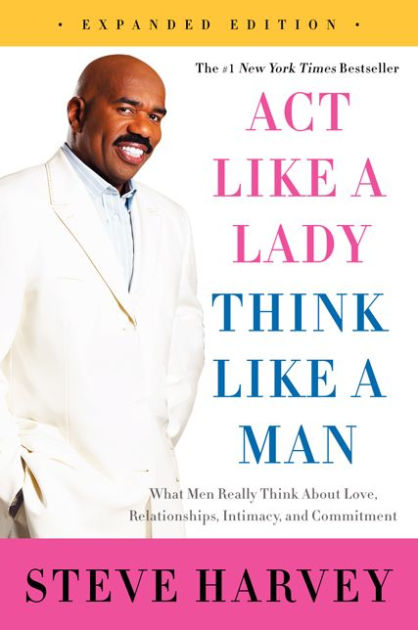What if the age-old adage “think like a man, act like a lady” held more truth than we ever acknowledged? This intriguing premise lies at the heart of “Act Like a Lady, Think Like a Man” by Steve Harvey, a book that delves deep into the complex dynamics of modern relationships. In a world where romantic encounters often resemble a tangled web of confusion, understanding the male psyche can feel like deciphering an ancient script. Harvey, a comedian turned relationship expert, meticulously explores the inner workings of male behavior and empowers women to navigate the sometimes murky waters of love with confidence and clarity.
The book opens with an inviting challenge: to reconsider how women approach relationships. What if, instead of succumbing to stereotypes or societal expectations, women embraced a more strategic outlook on dating? Harvey contends that, by gaining insights into how men think, women can not only enhance their romantic pursuits but also reclaim their power in relationship dynamics. This transformational mindset is not just about playing games; it’s about uncovering authenticity and fostering genuine connections.
One might wonder, what makes Harvey’s insights so compelling? The answer lies in his candidness and the anecdotes he shares. The author deftly intertwines humor with astute observations, creating a narrative that is both entertaining and enlightening. He draws on personal experiences, stories from other women, and the collective musings of men, delivering wisdom that resonates with readers across all walks of life.
As the narrative unfolds, readers are introduced to various archetypes of men. Harvey categorizes them into types such as “the Nice Guy,” “the Player,” and “the Dreamer,” each with distinct traits and relationship behaviors. This framework invites women to recognize patterns and tendencies, enabling them to approach their romantic interests with a more discerning eye. For instance, a woman who identifies her partner as a “Player” may decide to reassess her investment, while recognizing that “the Nice Guy” may offer emotional stability and sincerity. This classification fosters a sense of awareness—a tool that can significantly affect the outcome of romantic endeavors.
However, Harvey’s brilliance shines brightest when he delves into the concept of understanding men’s emotional vocabulary. He asserts that many men struggle to articulate feelings in the same manner as women. By embracing this reality, women can navigate conversations with empathy and clarity, fostering a deeper level of communication. Here emerges a thought-provoking question: How can women learn to engage with men by speaking their emotional language? This inquiry not only sets the stage for empowered discussions but also challenges the reader to step outside conventional scripts of communication.
Furthermore, Harvey implores women to respect themselves and value their worth, asserting that self-esteem is paramount in any relationship. “Men will not honor what you do not value,” he states, urging women to establish boundaries and to recognize that their individuality is an asset. This pivotal advice resonates in a world where women may often feel pressured to conform or to compromise their aspirations for the sake of romance. Actively maintaining one’s self-worth acts as a clarion call for women to ignite their dreams and passions beyond the realm of dating.
In addition to practical advice, “Act Like a Lady, Think Like a Man” is rife with illuminating metaphors. Harvey eloquently describes dating as a “dance,” encompassing rhythm, leading, and following. This metaphor captures the essence of romantic interaction, emphasizing that harmony and cooperation are fundamental to a flourishing partnership. A vivid visualization emerges—romantic relationships should never be a battle but rather an exquisite choreography, requiring both partners to be attuned to each other’s movements.
Moreover, the book does not shy away from the inevitable challenges that arise in relationships. Harvey candidly touches on topics such as infidelity, trust issues, and the painful prospect of rejection. Rather than shunning these difficult themes, he confronts them head-on, offering wisdom that encourages resilience and perseverance. The reader is beckoned to ponder: What lessons can be derived from heartache? How can one transform pain into a catalyst for growth in future relationships? By addressing these poignant questions, Harvey instills a sense of empowerment that resonates deeply, reminding readers that growth often sprouts from adversity.
The realism of Harvey’s assertions transforms the book into a treasure trove of encouragement. His evocative writing ultimately resonates with an earnest desire to foster understanding and connection between genders. The message is clear: embracing one’s identity while seeking comprehension of others is the cornerstone of successful relationships.
As the final pages turn, readers are left with a renewed sense of agency in their romantic lives. “Act Like a Lady, Think Like a Man” is not merely a guide; it is a clarion call for women to embrace their individuality while cultivating insight into the male experience. In an era fraught with confusion regarding relationships, Harvey’s words ring true: understanding is a two-way street, and every woman holds the capacity to navigate it with grace, tenacity, and unparalleled wisdom.
In summary, what will you choose for your own relationship journey? Will you lean into the knowledge that can empower you to build authentic connections, or will you remain ensnared in a cycle of miscommunication? The challenge lies in embracing the framework Harvey presents and unearthing the profound potential that lies within each partnership. With this book as your guide, step boldly into the realm of love and relationships—armed with insights, ready to think like a man while acting like a lady.
